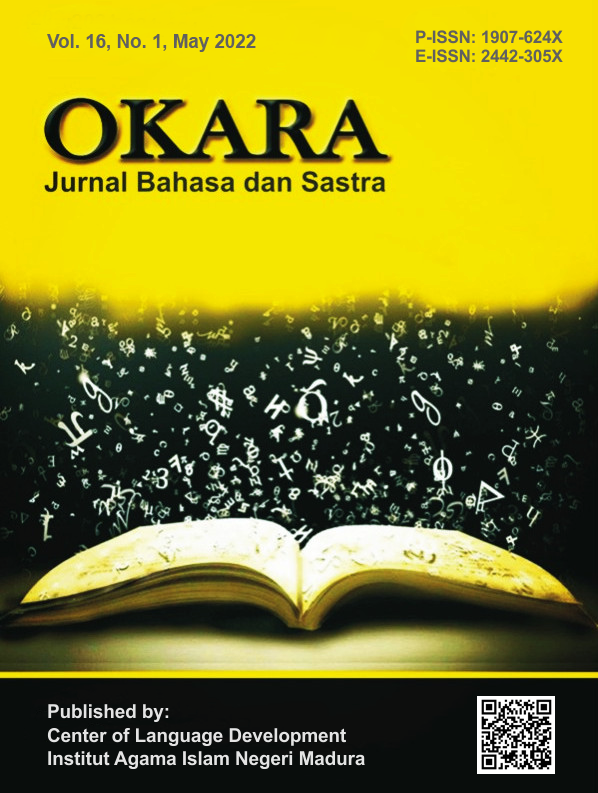'Oh,' 'Well,' and Hedges as Negative Politeness Strategy: The Different Use of Discourse Markers in Female and Male Students' Utterances
 Abstract views: 679
,
Abstract views: 679
,
 PDF downloads: 638
PDF downloads: 638
Abstract
Investigating gender differences in utterances by employing discourse markers is very interesting and challenging as the similarities and differences could be seen more distinctly than without them. This research aims to find out the similarities and the differences between them in students’ interactions. The data were taken from female and male students’ utterances. After being analyzed using the qualitative method, it concluded that there were some similarities and differences in applying them. For expressing hesitation, Female students use ‘Hmm…,’ (20%), ‘I think…,’ (17%), and ‘Well…,’ (15%). Meanwhile, male students use ‘Well…’ (19%), ‘I think...,’ (20%), and ‘Hmm…,’ (10%). Female students use ‘Well…’ as a face threat mitigator and sometimes followed by ‘sorry …,’ (12%), whereas male students employ ‘Well…’ (7%). For expressing surprise, both use ‘Oh’ as a pure surprise (9%) and (6%). Female students prefer to use discourse markers ‘Wow…,’ (7%) if they feel amazed, whereas male students apply ‘Aah…,’ (6%). Both female and male students employ ‘By the way…,’ to interrupt (8%). The research revealed that male students hide their doubts better than female students; female students are more polite. The research also finds discourse markers from students’ local language that could be developed globally.
Downloads
References
Aijmer, Karin. English Discourse Particles: Evidence from a Corpus. Vol. 10. Amsterdam: John Benjamins Publishing, 2002.
Alami, Manizheh. “Pragmatic Functions of Discourse Markers: A Review of Related Literature.” International Journal on Studies in English Language and Literature (IJSELL) 3, no. 3 (2015): 1–10. https://doi.org/10.13140/RG.2.1.3034.3121.
Ali, Eman Awni. “The Use of Interpersonal Discourse Markers by Students of English at the University of Jordan.” SSRN Electronic Journal 6, no. 3 (2016): 23–35. https://doi.org/10.2139/ssrn.2847459.
Alshebl, Alia. “Journal of Language Relationship.” Journal of Language Relationship 17, no. 1 (2021): 534–52.
Banguis-Bantawig, Renalyn. “The Role of Discourse Markers in the Speeches of Selected Asian Presidents.” Heliyon 5, no. 3 (2019): e01298. https://doi.org/10.1016/j.heliyon.2019.e01298.
Brown, Penelope, and Stephen C. Levinson. Politeness: Some Universals in Language Usage. Cambridge: Cambridge University Press, 1987.
Escalera, Elena Andrea. “Gender Differences in Children’s Use of Discourse Markers: Separate Worlds or Different Contexts?” Journal of Pragmatics 41, no. 12 (2009): 2479–95. https://doi.org/10.1016/j.pragma.2006.08.013.
Fox Tree, Jean E., and Josef C. Schrock. “Discourse Markers in Spontaneous Speech: Oh What a Difference an Oh Makes.” Journal of Memory and Language 40, no. 2 (1999): 280–95. https://doi.org/10.1006/jmla.1998.2613.
Fraser, Bruce. “What Are Discourse Markers?” Journal of Pragmatics 31, no. 7 (1999): 931–52. https://doi.org/10.1016/S0378-2166(98)00101-5.
Jucker, Andreas H. “The Discourse Marker Well: A Relevance-Theoretical Account.” Journal of Pragmatics 19, no. 5 (1993): 435–52. https://doi.org/10.1016/0378-2166(93)90004-9.
Lin, Yen-Liang. “Discourse Marking in Spoken Intercultural Communication between British and Taiwanese Adolescent Learners.” Pragmatics. Quarterly Publication of the International Pragmatics Association (IPrA) 26, no. 2 (2016): 221–45. https://doi.org/10.1075/prag.26.2.03lin.
McIntosh, Michele J., and Janice M. Morse. “Situating and Constructing Diversity in Semi-Structured Interviews.” Global Qualitative Nursing Research 2 (2015): 1-12. https://doi.org/10.1177/2333393615597674.
Merchant, Karima. “How Men and Women Differ: Gender Differences in Communication Styles, Influence Tactics, and Leadership Styles.” Senior Theses, Claremont McKenna College, 2012. http://scholarship.claremont.edu/cmc_theses/513.
Nejadansari, Dariush, and Ali Mohamad Mohammadi. “The Frequencies and Functions of Discourse Markers in the Iranian University EFL Classroom Discourse.” International Journal of Research Studies in Language Learning 4, no. 2 (2014): 3–20. https://doi.org/10.5861/ijrsll.2014.840.
Pasaribu, T. A. “Male and Female Students’ Use of Textual Discourse Markers in Writing Academic Essays.” Journal of Language and Literature 17, no. 1 (2017): 74–81. https://doi.org/10.24071/joll.v17i1.587.
Robson, J, B Francis, and B Read. “Gender, Student Confidence and Communicative Styles at University: The Views of Lecturers in History and Psychology.” Studies in Higher Education 29, no. 1 (2004): 7–23. https://doi.org/10.1080/1234567032000164840.
Salager-Meyer, Oise. “I Think That Perhaps You Should : A Study of Hedges in Written Scientific.” Functional Approaches to Written Text: Classroom Applications, 1997, 105–18.
Trihartanti, Ratna Padmi, and Damayanti Diana. “The Use of ‘Oh’ and ‘Well’ as Discourse Markers in Conversation of Bandung State Polytechnic Students.” Language Education and Acquisition Research Network (LEARN) Journal 7, no. 1 (2014): 22–44.
Vanda, K. H., and F. B. Péter. “Gender Differences in the Dse of the Discourse Markers You Know and I Mean.” Argumentum 7 (2011): 1–18.
Villegas, Cristian Lopez. “Discourse Markers and Pragmatic Markers in Spoken and Written Everyday Life.” Interdisciplinary Lens into Human Language, Identity, Conversation, Interaction, Discourse, Social Construction, Institutions, Society, Ontology, 2019, 1–46. https://doi.org/10.13140/RG.2.2.33992.57602.
Wang, Jixian. “Qualitative Research in English Language Teaching and Learning.” Indonesian EFL Journal: Journal of ELT, Linguistics, and Literature 4, no. 2 (2018): 116–32.
Yeganeh, Maryam Tafaroji, and Seyedeh Marzieh Ghoreyshi. “Exploring Gender Differences in the Use of Discourse Markers in Iranian Academic Research Articles.” The Proceedings of 2nd Global Conference on Conference on Linguistics and Foreign Language Teaching, 192 (2015): 684–89. https://doi.org/10.1016/j.sbspro.2015.06.104.
The journal operates an Open Access policy under a Creative Commons Attribution-NonCommercial 4.0 International License. Authors who publish with this journal agree to the following terms:
- Authors retain copyright and grant the journal right of first publication with the work simultaneously licensed under a Creative Commons Attribution License that allows others to share the work with an acknowledgement of the work's authorship and initial publication in this journal.
- Authors are able to enter into separate, additional contractual arrangements for the non-exclusive distribution of the journal's published version of the work (e.g., post it to an institutional repository or publish it in a book), with an acknowledgement of its initial publication in this journal.
- Authors are permitted and encouraged to post their work online (e.g., in institutional repositories or on their website) prior to and during the submission process, as it can lead to productive exchanges, as well as earlier and greater citation of published work.





_(1).png)
.png)
.png)
1.png)
.png)
.png)

.png)
_-_Copy_-_Copy.png)





